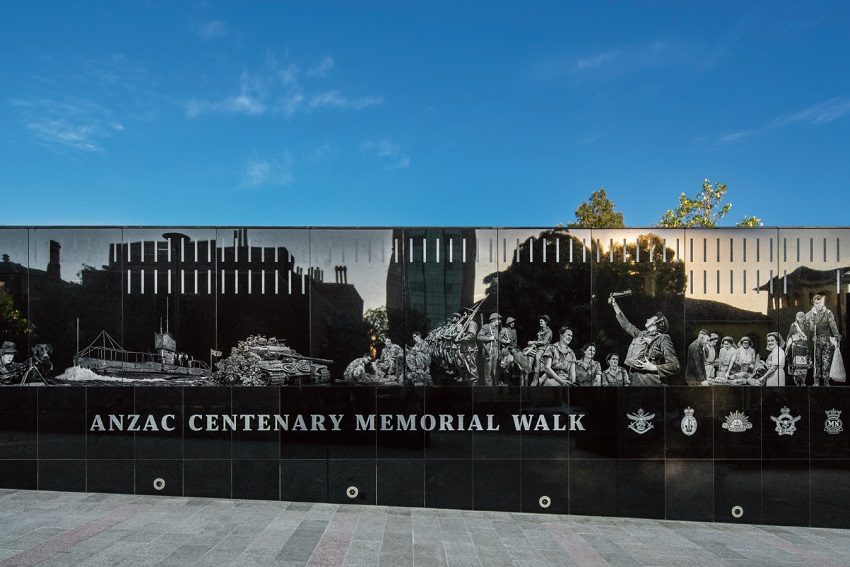ANZAC Centenary Memorial Walk's Meaningful Collaboration

Aside from being a beautiful yet sombre place for remembrance, the ANZAC Centenary Memorial Walk has also drastically improved the landscape of its surrounding area and opened up part of Government House to the public. In their own words, architects Steve Grieve and Elizabeth Little (Grieve Gillett Andersen), as well as Veterans SA director Rob Manton, discuss the collaboration that made it happen.
Manton: The project started back in the late ‘90s when Premier Weatherill was the Planning Minister. It was proposed to have a boulevard down Kintore Avenue, but it was more of an urban renewal project than a memorial project. One of the first tasks of the Veterans’ Advisory Council, when it was established in 2008, early 2009, was to identify, looking forward to 2014 (the centenary of WWI) a series of projects that could be proposed to commemorate SA’s involvement.
There were a number of projects that were put forward. The Memorial Walk became ‘the project’. It went through various iterations of how wide it ought to be, how much land from Government House ought to be requested – various things. There were lots of discussions around that to the point where, I assumed this role in October 2014, nothing much had really moved. Martin Hamilton-Smith, who’s a veteran himself, and I got our heads together and said, ‘we’re going to push this’. In late 2014, we started making some proposals to a then fairly new governor, Hieu Van Le.

(photo: Peter Barnes)
The idea was to do a project for the centenary of the First World War that would commemorate South Australia, but even more broadly, Australia’s involvement in the conflict. I coined the term ‘a memorial for all, not a few’. That was designed around, saying to everybody, this is about home and abroad, this is not about discriminating between any conflict or any unit, service, association. We didn’t want to highlight the service of any individual.
Grieve: We had renovated the Torrens Parade Ground some years ago. So, we had a long lasting relationship with that precinct. A major key to the outcome of the project was our ability to develop a quick rapport with Rob and the veteran community. It was a tight time-frame, we were engaged around June or July 2015, and the absolute deadline was April 23, 2016. It was an incredibly tight time-frame for a project not only in terms of the cultural significance but just in terms of the building time to do that much work.
The landholding of Government House was to be reduced by 10 metres. It was obvious to open Government House to the public domain. There was a 2.5-metre high brick wall that had been there since the ‘30s, the footpath was just over a metre wide, it was a fairly poor urban environment. The notion of opening up the landscape of Government House to the public domain was something that we debated with the Governor, he was great to deal with: open and easy.

(photo: Robyn Oliver)
We quickly worked out that there were various opportunities offered by the presence of Government House itself, in that it has a public and private face. This gave us an opportunity to have a solid wall along part of its length, which allowed us a canvas. We developed this idea of steel blades, so the view unfolds as you walk past, so you can never see a 45-degree view of the garden [at Government House], you’ve always got a 90-degree view.
Our team [Grieve Gillett Andersen] were terrific: Elizabeth Little and Esther Chew, especially. Esther prepared a lot of the artwork [for the wall]. She sourced imagery from the national archives and prepared the collages, effectively stitched together a whole bunch of photographs. The imagery was to incorporate all the people affected by war, not only all the people who were out in the theatres of war but also the people in Australia supporting them.
 (photo: Peter Barnes)
(photo: Peter Barnes)
One of the constraints we had was that we were to use South Australian materials, so we’re fortunate in this state that we have a range of granites. We used the black granite form the Adelaide Hills, granite from Eyre Peninsula and the green granite from the South East. The black granite is reflective – the background is reflected in the wall as well as the imagery, so you get this sense of ghost-like imagery, without wanting to use the word ghost, but this ethereal floating in the ether feeling about it.
Manton: The opening was done on April 23. We finished on the morning of the 23rd. Never waste a good deadline.

(photo: Kate Elmes)
Grieve: It feels right. It feels refreshing. I really like that you can see into Government House, that’s been a great outcome. I know earlier governors might have resisted that. Hieu Van Le has been very accommodating in embracing it.
Manton: As Steve says, it looks like it’s always been there. And then you come to the wall, you want to stop and have a look. You want to ask questions.
Little: It is a place of reflection, it is also quite a solemn place in some respects, but it does invite people to engage with it and you can see people doing that all the time. The fact that they’re interested in interacting with it, so they’re not just walking down a footpath, I think that’s nice that people feel they can do that.
Header photo: (photo: Peter Barnes)